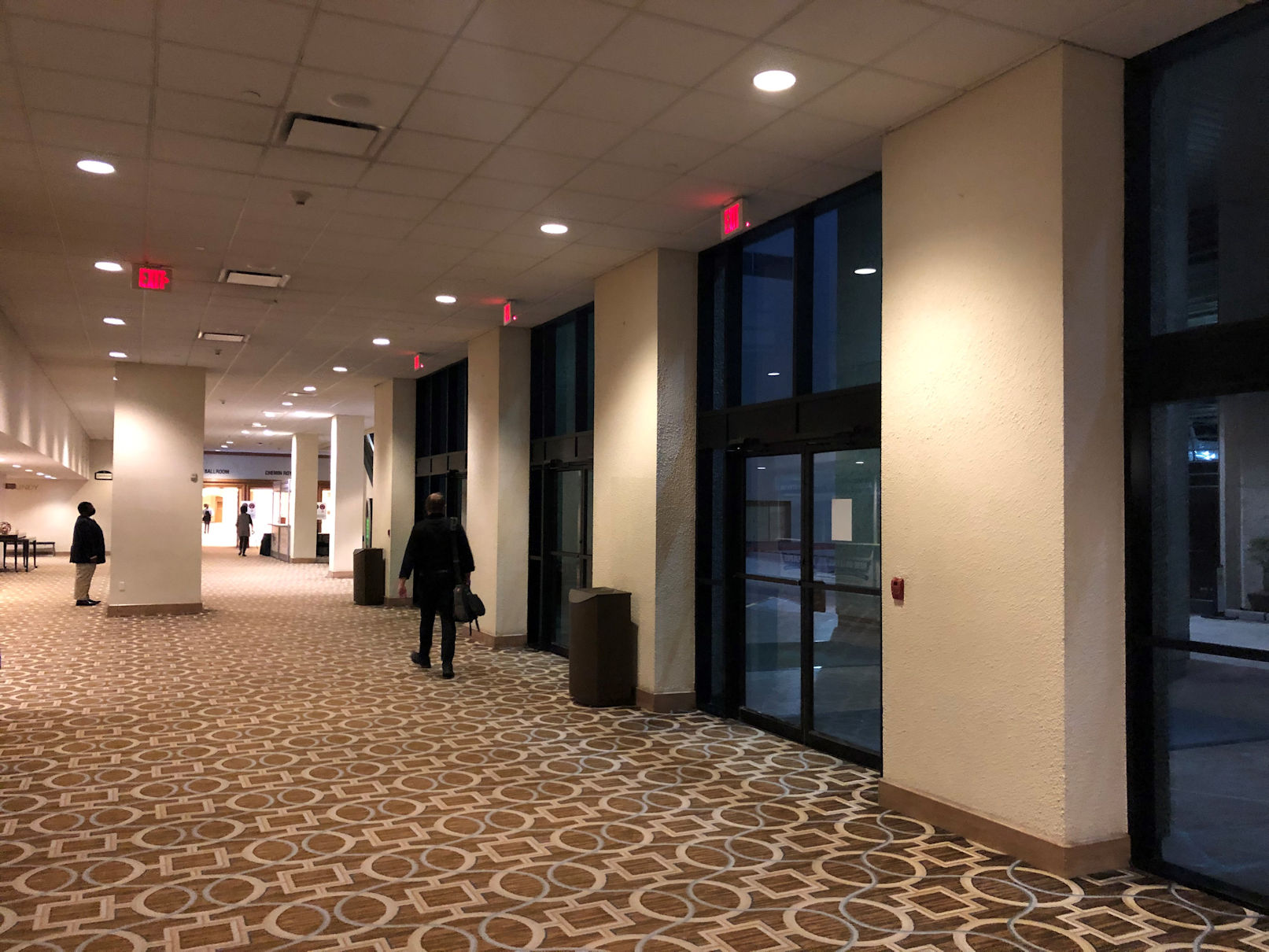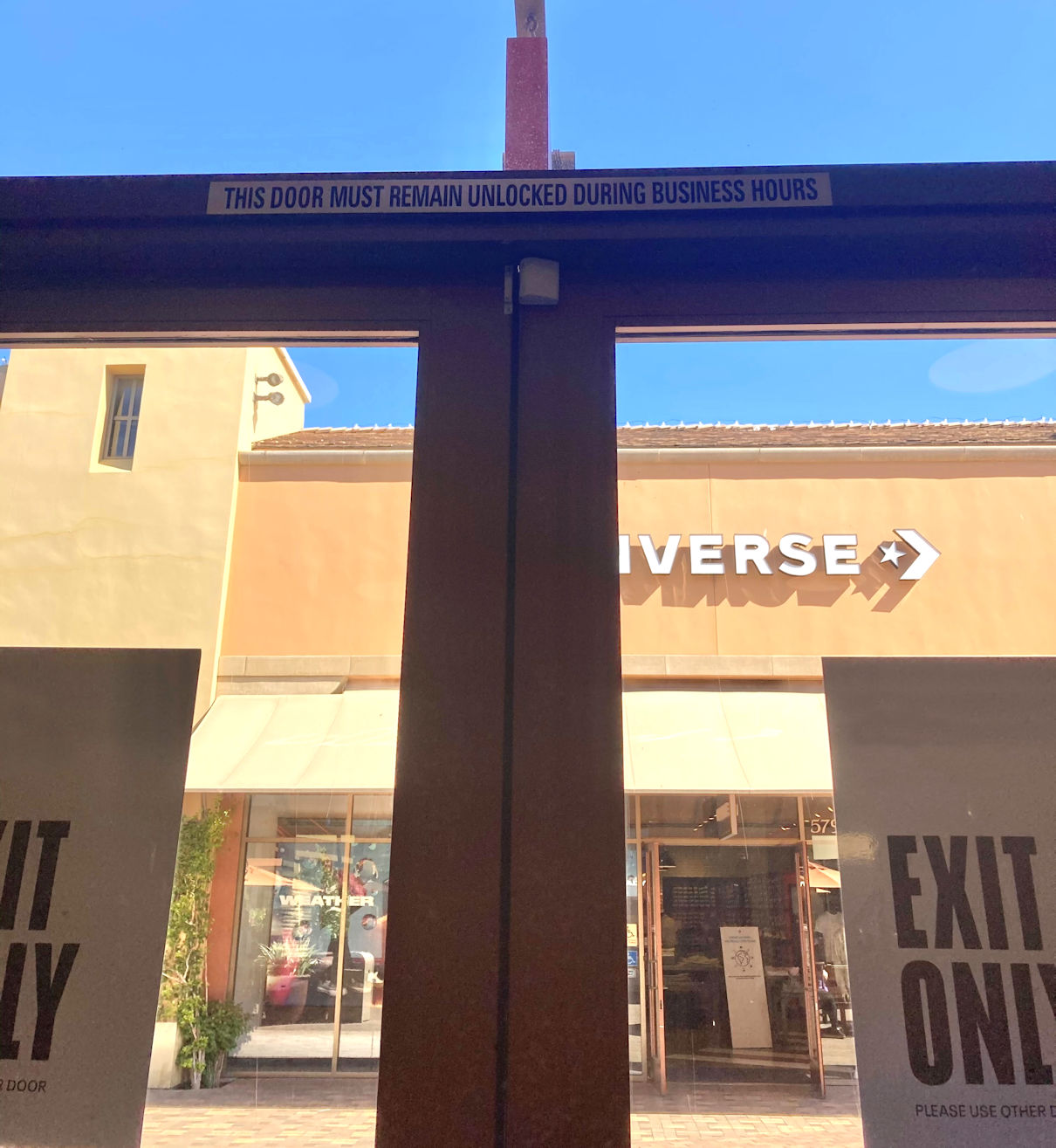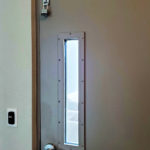I was recently contacted by a specwriter who had specified double-cylinder deadbolts for the main entrance to an assembly occupancy. Although the AHJ had originally approved the plan, he changed his mind after the doors and hardware were installed. The opening had the proper signage required by code (“This door to remain unlocked when this space is occupied.”), and the lock had an indicator so that it was readily distinguishable as locked. The inactive leaf had automatic flush bolts and didn’t have a push bar or pull on the egress side – this is above and beyond what I usually see in this application. The doors often have manual flush bolts and a stationary push bar on the inactive leaf – even though this is not technically allowed in many locations.
 After installation, the AHJ revoked the use of the key-operated lock – this is specifically addressed by the IBC: “The use of the key-operated locking device is revocable by the building official for due cause.” What makes this application especially risky to specify is that an AHJ could revoke permission at any point during the life of the building. For this reason I have almost never specified double-cylinder deadbolts on main entrance doors (or anywhere else). Even when an architect or specifier follows exactly what is required by code, an AHJ could revoke permission and at that point it could become an expensive change. There’s just no way to know.
After installation, the AHJ revoked the use of the key-operated lock – this is specifically addressed by the IBC: “The use of the key-operated locking device is revocable by the building official for due cause.” What makes this application especially risky to specify is that an AHJ could revoke permission at any point during the life of the building. For this reason I have almost never specified double-cylinder deadbolts on main entrance doors (or anywhere else). Even when an architect or specifier follows exactly what is required by code, an AHJ could revoke permission and at that point it could become an expensive change. There’s just no way to know.
When I was in New Orleans last week, I came across some egress doors with double-cylinder deadbolts in my means of egress. These doors had no signage and no indicators. When I tried to use the doors early in the morning, they were all locked. As you can see from the photo, I was not the only person awake at that hour (7 a.m.). I can see why the hotel would want those doors locked – especially at night – but locking them with a key-operated lock created a non-code-compliant situation. There are plenty of other hardware options that would have provided the necessary security without compromising egress.
An iDigHardware reader just sent me another example, where the doors have the required signage and indicator deadbolt, but were locked when the retail store was occupied. This adds another risk factor – when we specify a project, we have no idea if future owners or occupants will use the doors as required by code. So whether the risk comes from the potential for AHJ disapproval, or from the doors being locked when they are not allowed to be, there are definitely risks associated with this application. Specifier beware!
You need to login or register to bookmark/favorite this content.











These are frustrating to read. If you feel the need as a specwriter to contact an AHJ to seek special permission to put a non-approved lock on exit doors, you shouldn’t be considering specifying that lock.
You should have a much easier time defending full compliance to the code than giving in to requests for locking devices that are not approved or even a good idea for that matter.
Life safety is always first priority. That’s one of the few rules without exception.
Hi Mark –
The specwriter didn’t contact the AHJ to ask special permission for a non-approved lock. This type of lock is specifically allowed by the model codes if certain criteria are met, but the same section of the code also says that the AHJ can revoke permission for due cause. The door was not flagged during the plan review, but after installation the AHJ revoked permission because the lock might not be used properly in the future.
– Lori
In an assembly occupancy? I thought that exception only applied to a Business/Mercantile type main entry.
Here is where key-operated locks are allowed by the IBC: In buildings in occupancy Group A having an occupant load of 300 or less, Groups B, F, M and S, and in places of religious worship, the main door or doors are permitted to be equipped with key-operated locking devices from the egress side provided…
– Lori
I like the mannikins running towards the egress door. This is good advice! Thanks as always Lori?
I’ve always interpreted the statement “with due cause” to be a situation where the doors were discovered to be locked when the building was occupied, demonstrating to the AHJ that the owner should not be trusted to operate the main entrance doors as described in the code. I’m not sure why I interpret it that way, it just seems obvious. The AHJ having a change of heart on a whim – that isn’t due cause and it’s not fair to the owner.
and don’t lose your head while rushing to the door!
As Lloyd says, it is completely unfair to the owner. Unfortunately, we have seen this happen several times. We had an AHJ require us to install Push to Exit buttons on an access control doors with free egress Cylindrical Locks and Electric Strikes, on the day of final inspection! Funny part if there is any, is that the Fire Permit office had the same setup without the PTEs. Even worse, we had a Delayed Egress application, fully compliant with NFPA and IBC, which the Fire reviewer approved it and the inspector approved our final inspection, only to have the same inspector show up the day the customer was moving in and demanded the DE to be removed or he would cancel the CO for the space. Happy times!
Oh no! That’s terrible! I’m doing my best to educate AHJs and others about what the code requirements for electrified hardware mean, but it’s a long process!
– Lori
And we truly appreciate what people like you are doing to help with this. Hopefully one day the code will have a clear distinction between a magnetic lock access control door and one with a electromechanical lock. Been dreaming of that for a couple of decades. LOL. Cheers!
Hi Mario –
The 2024 IBC will have a change that will help with this…it will still take some education to make sure everyone understands the intent, but hopefully the Commentary language will clarify that.
– Lori
Just about the only place I’ll use a double cylinder deadbolt is with a passage on a non-egress Roof Access Door.
That’s what I prefer to use for that application also.
– Lori
A much better balance needs to be achieved within all of the Codes in terms of the authority granted to AHJ’s. We have all seen AHJ’s who sign off during plan review and then go 180 or even 360 during a final walk-thru for CO which leads to delays and cost overruns for builders and property owners.
It is one thing to revoke permission when a property owner allows, ignores, or abuses Code requirements. It is quite another to make builders and property owners bear the cost of failures by the AHJ to perform a competent plan review.
The sad truth is not all AHJ’s have the same level of experience, education, or training related to all of the trades, crafts, and specialties involved in completing a complex building project. Ask the same Code question to a bunch of different AHJ’s and the variety of answers received will often be as different as night and day. Even worse is their answers are more often than not based upon personal preferences and biases rather than technical or scientific facts. Who hasn’t heard an AHJ reply, “because I say so”?
It is long past time for the “Code experts”, those sitting on the Code committees and charged with writing and updating the Codes, to stop waffling and putting the responsibility on the AHJ’s to make their decisions, decisions a great majority of the AHJ’s have no technical competence to make other than the authority granted to them by the Code. At least 90% of the AHJ allowances in Codes today do not need to be there and the community that uses Codes, as well as the safety of the general public, would be better served by working to remove these Code allowances once and for all time.
However, if the Code industry should develop a training, education, and independent professional certification and continuing education process for AHJ’s similar to other professional certification organizations I would be open to the possibility of AHJ’s retaining closer to fifty percent of the discretion currently afforded to them by the Codes.